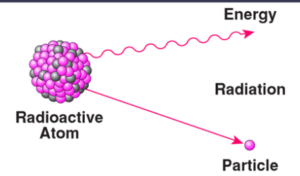Table of Contents
When an atom radioactively decays, it emits particles such as alpha, beta, and gamma rays. Radioactivity occurs primarily as an unstable atom attempts to achieve stability. As a result, when they become unstable, they decay by emitting a particle that transforms the nucleus into another nucleus or into a lower energy state. This chain of decays continues until the nucleus reaches a stable state. Radiation emitted by radioactive particles is classified into three types.
These are known as the alpha, beta, and gamma rays. All of these radiations are emitted by the atom’s nucleus. Though all three cause some ionisation and have some penetration power, their behaviour differs.
Three different types of radioactive rays, alpha, beta, and gamma-emitting from radioactive substances in the radiation process, according to the properties. The magnetic and electric fields deflect alpha and beta particles, but gamma-rays are wave-motion with very small wavelengths.

Alpha Rays
Positively charged particles are alpha rays. The alpha particle is a highly active and energetic helium atom composed of two neutrons and protons. These particles have the least penetration power but the greatest ionization power. Because of their high ionization power, they can cause serious harm if they enter the body. They are capable of ionizing a large number of atoms over a short distance. It is due to the fact that radioactive substances that emit alpha particles must be handled while wearing rubber gloves.
Beta Rays
The inner nucleus releases extremely energetic electrons known as beta particles. They have a negligible mass and a negative charge. When a beta particle emits, a neutron in the nucleus splits into a proton and an electron. As a result, the electron is rapidly emitted by the nucleus. When compared to alpha particles, beta particles have a greater penetration power and can easily pass through the skin. Even though their ionization power is low, beta particles can be dangerous and should be avoided if they come into contact with the body.
Gamma Rays
Gamma rays are waves that originate at the high-frequency end of the electromagnetic spectrum and have no mass. They have the most penetrating power. They are the most penetrating but least ionizing, and it is extremely difficult to keep them out of the body. Gamma rays have a high energy density and can travel through thick concrete and thin lead. Gamma-ray properties include electromagnetic spectrum radiation of very short wavelength ( 0.005–1) in learning chemistry or physics. These are photons with a lot of energy. The emission of alpha or beta particles causes a change in the energy of the nucleus during all nuclear reactions. The unstable, excited nucleus produced by the emission of an alpha or beta particle emits a photon and falls into a lower, more stable energy state. As gamma rays do not carry charge or mass, their emission cannot alter the mass number or nucleus properties in chemistry or physics.
FAQs:
Q. What exactly are the characteristics of a beta particle?
Ans: Beta particles have a mass half a thousandth that of a proton and can carry a single negative (electron) or positive (positron) charge.
They can reach relativistic speeds because they have a small mass and can be released with a lot of energy (close to the speed of light).
What exactly is the distinction between beta particles and gamma rays?
Gamma rays are photons, which are weightless packets of energy. Gamma rays are pure energy, as opposed to alpha and beta particles, which have both energy and mass. Gamma rays are similar to visible light but much more energetic. During radioactive decay, gamma rays are frequently emitted alongside alpha or beta particles.







